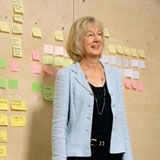Profile: Lesley Morris

Lesley Morris is the Design Council’s self-effacing head of skills, and she has managed to get the industry excited about education, skills and learning. She tells Mike Exon how she did it
When the Design Council launched its Keep British Design Alive campaign in May (DW 11 May), the telephones rang off their cradles with disgruntled designers who had taken umbrage at the message. But Lesley Morris wasn’t complaining. As one of the architects of the industry consultation, Morris was aware that just asking designers for their views on ‘skills’ would have been a bit like trying to tempt a class of graphics students to a talk on financial management.
Judging by Design Week’s mail bag, the calculation may just have paid off for Morris and her colleagues, even if the campaign has ‘touched a nerve’, as Design Council chief executive David Kester put it. Some 600 responses have been chalked up to date and its on-line forum is awash with postings from all corners of designland, ranging from the thoughtful to the downright provocative.
Morris clearly didn’t set out to become one of the industry’s big personalities, but her thoughtful, balanced manner has earned her great respect within design. She was an interior designer by training, but stepped sideways into education about 15 years ago when she was asked to set up the design leadership MA course at Middlesex University’s design department at Cat Hill. She moved to the Design Council five years later.
‘When I first joined the Design Council there was an education team and we mainly worked to support design education in schools, colleges and universities. So I was involved in creating resources like teaching and learning materials to sit alongside the Channel Four series that Richard Seymour and Dick Powell did (“Designs on Your…” and “Better by Design”),’ Morris explains.
‘We put together information about issues such as inclusive design, and initiatives like Designers into Schools. I also worked with business education – supporting the development of design awareness in future business managers – again mainly by providing resources,’ she continues.
The next stage for Morris was the development of the Design Council’s campaigns, which were designed to test and pilot new initiatives.
‘I developed projects such as Platform and Inside Track, where we were looking at ways to develop the professional skills of design students. This has led to the work we’re currently doing with Creative & Cultural Skills, where we are keen to support the future development of the supply side of design,’ she says.
Morris is now head of design skills at the Design Council and, with the formation of the Sector Skills Development Agency by central Government in April 2002, skills is an issue that has shot up the business agenda. The SSDA was inaugurated by the Department for Education and Skills and divides itself into 25 councils, one for each business sector. Creative and Cultural Skills is the skills council for the creative industries – more specifically for design, advertising, crafts, music, performing arts, literary and visual arts, and cultural heritage.
The Design Council signed an agreement with Creative and Cultural Skills in December 2004 to take forward a skills initiative across the professional and educational spheres. Morris helped to put together a 25-strong Design Advisory Panel from all quarters of the design industry to look at the needs of schools, colleges and the workplace. It meets four times a year, in a bid to co-ordinate skills work in the sector and the Design Council’s involvement with the CCS.

‘The CCS doesn’t have specific knowledge of individual industries, so it creates partnerships with bodies like the Design Council. The agreement we signed with the CCS in 2004 was to work in partnership to develop a Design Skills Development Plan, and what’s important is that taking this forward will not be purely down to us,’ she says.
The first real fruits of all this has been the infamous aforementioned consultation, which can still be accessed for a few more days at www.keepbritishdesignalive.com. The panel will then meet at the end of the month to discuss the results and to feed them back to the design world. Any recommendations will come later, and Morris knows that they could be as contentious as the campaign.
-
Post a comment




